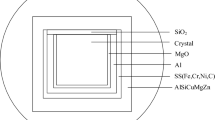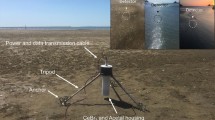Abstract
Monte Carlo simulations were performed using the GEANT4 code for the investigation of γ-ray absorption in water in different spherical geometries and of the efficiency of a NaI(Tl) detector for different radionuclides in the aquatic environment. In order to test the reliability of these simulations, experimental values of the NaI(Tl) detector efficiency were deduced and seem to be in good agreement with the simulated ones. In addition, using the simulated efficiency, an algorithm was developed to determine the minimum detectable activity in becquerels per cubic meter in situ as a function of energy for typical freshwater and seawater spectra.
Similar content being viewed by others
References
Aakenes, U. R. (1995). Radioactivity monitored from moored oceanographic buoys. Chemistry and Ecology, 10, 61–69. doi:10.1080/02757549508035330.
Aničin, I. V., & Yap, C. T. (1987). New approach to detection limit determination in spectroscopy. Nuclear Instruments & Methods in Physics Research. Section A, Accelerators, Spectrometers, Detectors and Associated Equipment, 259, 525–528. doi:10.1016/0168-9002(87)90835-7.
Baranov, I., Kharitonov, I., Laykin, A., & Olshansky, Y. (2003). Devices and methods used for radiation monitoring of sea water during salvage and transportation of the Kursk nuclear submarine to dock. Nuclear Instruments & Methods in Physics Research. Section A, Accelerators, Spectrometers, Detectors and Associated Equipment, 505, 439–443. doi:10.1016/S0168-9002(03)01116-1.
Berger, M. J., & Hubell, J. H. (1995). XCOM: Photon cross sections, with a personal computer. NBSIR 87-3597.
CERN (1993). GEANT detector description and simulation tool. Geneva: CERN Program Library Office.
Crespin, S., De Freitas, D., Brette, P., Falvard, A., & Maublant, J. (2004). Assessment of a simulation software for scintillation detector. Nuclear Instruments and Methods A, 527, 206–210. doi:10.1016/j.nima.2004.03.121.
Currie, L. A. (1968). Limits for qualitative detection and quantitative determination. Analytical Chemistry, 40, 586–593. doi:10.1021/ac60259a007.
Currie, L. A. (1995). Nomenclature in evaluation of analytical methods including detection and quantification capabilities. Pure and Applied Chemistry, 67, 1699–1723. doi:10.1351/pac199567101699.
Debertin, K., & Helmer, R. G. (1988). Gamma- and x-ray spectrometry with semiconductor detectors. Amsterdam: North-Holland.
Fayez, H. H., & Al-Ghorabie. (2006). Development of a computer code using the EGS4 Monte Carlo simulation system to evaluate the response of a NaI(Tl) detector to photons with energies below 300 keV. Applied Radiation and Isotopes, 64, 85–92. doi:10.1016/j.apradiso.2004.12.013.
Ghanem, S. A. (2000). Monte Carlo calculations of the response features for NaI detectors. Applied Radiation and Isotopes, 53, 877–880. doi:10.1016/S0969-8043(00)00257-8.
Gilmore, G., & Hemingway, J. (2000). Practical gamma-ray spectrometry. New York: Wiley.
Hurtado, S., Garcia-Leon, M., & Garcia-Tenorio, R. (2004). GEANT4 code for simulation of a germanium gamma-ray detector and its application to efficiency calibration. Nuclear Instruments and Methods A, 518, 764–774. doi:10.1016/j.nima.2003.09.057.
Karamanis, D. (2003). Efficiency simulation of HpGe and Si(Li) detectors in γ- and X-ray spectroscopy. Nuclear Instruments & Methods in Physics Research. Section A, Accelerators, Spectrometers, Detectors and Associated Equipment, 505, 282–285. doi:10.1016/S0168-9002(03)01069-6.
Klusoň, J. (2001). Environmental Monitoring and in-situ gamma spectrometry. Radiation Physics and Chemistry, 61, 209–216. doi:10.1016/S0969-806X(01)00242-0.
Nir-El, Y., & Haquin, G. (2001). Minimum detectable activity in in situ γ-ray spectrometry. Applied Radiation and Isotopes, 55, 197–203. doi:10.1016/S0969-8043(00)00377-8.
Mertens, C., De Lellis, C., Van Put, P., & Tondeur, F. (2007). MCNP simulation and spectrum unfolding for an NaI monitor of radioactivity in aquatic systems. Nuclear Instruments & Methods in Physics Research. Section A, Accelerators, Spectrometers, Detectors and Associated Equipment, 580, 118–122. doi:10.1016/j.nima.2007.05.049.
Ocone, R., Kostezh, A., Kurinenko, V., Tyshchenko, A., Derkash, G., & Leone, P. (2004). Substrate characterization for underwater spectrometry: tank measurements results utilizing efficiencies calculated via Monte Carlo code. Applied Radiation and Isotopes, 61, 129–132. doi:10.1016/j.apradiso.2004.03.033.
Osvath, I., Povinec, P. P., Livingston, H. D., Ryan, T. P., Muslow, S., & Commanducci, J.-F. (2005). Monitoring of radioactivity in NW Irish Sea water using a stationary underwater gamma-ray spectrometer with satellite data transmission. Journal of Radioanalytical and Nuclear Chemistry, 263, 437–440.
Povinec, P. P., Osvath, I., & Baxter, M. S. (1996). Underwater gamma-spectrometry with HpGe and NaI(Tl) detectors. Applied Radiation and Isotopes, 47, 1127–1133. doi:10.1016/S0969-8043(96)00118-2.
Shi, Q., Zhang, J., Chang, Y., & Qian, S. (2005). Comparison between summing-up algorithms to determine areas of small peaks on high baselines. Nuclear Instruments & Methods in Physics Research. Section A, Accelerators, Spectrometers, Detectors and Associated Equipment, 555, 220–224. doi:10.1016/j.nima.2005.09.013.
Soukissian, T. H., Chronis, G. T., & Nittis, K. (1999). POSEIDON: Operational marine monitoring system for Greek seas. Sea Technology, 40, 31–37.
Srinivasan, P., Raman, A., & Sharma, D. N. (2001). Assement of calibration parameters for an aerial gamma spectrometry system using Monte Carlo technique. Environmental Monitoring and Assessment, 75, 73–85.
Tsabaris, C., & Ballas, D. (2005). On line gamma-ray spectrometry at open sea. Applied Radiation and Isotopes, 62, 83–89. doi:10.1016/j.apradiso.2004.06.007.
Tsabaris, C., Bagatelas, C., Dakladas, T., Papadopoulos, C. T., Vlastou, R., & Chronis, G. T. (2008). An autonomous in situ detection system for radioactivity measurements in the marine environment. Applied Radiation and Isotopes, 66, 1419–1426. doi:10.1016/j.apradiso.2008.02.064.
van Put, P., Debauche, A., De Lellis, C., & Adam, V. (2004). Performance level of an autonomous system of continuous monitoring of radioactivity in seawater. Journal of Environmental Radioactivity, 72, 177–186. doi:10.1016/S0265-931X(03)00200-5.
Vlachos, D. S., & Tsabaris, C. (2005). Response function calculation of an underwater gamma ray NaI(Tl) spectrometer. Nuclear Instruments & Methods in Physics Research. Section A, Accelerators, Spectrometers, Detectors and Associated Equipment, 539, 414–420. doi:10.1016/j.nima.2004.10.001.
Vlastou, R., Ntziou, I. T., Kokkoris, M., Papadopoulos, C. T., & Tsabaris, C. (2006). Monte Carlo simulation of γ-ray spectra from natural radionuclides recorded by a NaI detector in the marine environment. Applied Radiation and Isotopes, 64, 116–123. doi:10.1016/j.apradiso.2005.07.011.
Vojtyla, P. (2001). Calibration of monitors used for surveillance of radioactivity in effluent water from CERN’s accelerator installations. Applied Radiation and Isotopes, 55, 81–88. doi:10.1016/S0969-8043(00)00361-4.
Wedekind, C., Schilling, G., Grüttmüller, M., & Becker, K. (1999). Gamma-radiation monitoring network at sea. Applied Radiation and Isotopes, 50, 733–741. doi:10.1016/S0969-8043(98)00062-1.
Weise, K., Hübel, K., Rose, E., Schläger, M., Schrammel, D., Täschner, M., et al. (2006). Bayesian decision threshold, detection limit and confidence limits in ionising-radiation measurement. Radiation Protection Dosimetry, 121, 52–63. doi:10.1093/rpd/ncl095.
Author information
Authors and Affiliations
Corresponding author
Rights and permissions
About this article
Cite this article
Bagatelas, C., Tsabaris, C., Kokkoris, M. et al. Determination of marine gamma activity and study of the minimum detectable activity (MDA) in 4pi geometry based on Monte Carlo simulation. Environ Monit Assess 165, 159–168 (2010). https://doi.org/10.1007/s10661-009-0935-4
Received:
Accepted:
Published:
Issue Date:
DOI: https://doi.org/10.1007/s10661-009-0935-4




